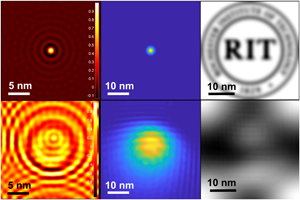Article contents
SEM Nano: An Electron Wave Optical Simulation for the Scanning Electron Microscope
Published online by Cambridge University Press: 22 February 2022
Abstract

The simulation program “SEM Nano” is introduced to explain and visualize probe formation in field-emission scanning electron microscopes (SEMs). The program offers an easy and intuitive graphical user interface (GUI) to provide input in terms of understandable SEM parameters and visualization of the output. The simulations are based on wave optics treatment of the electron beam in the SEM column. Based on input parameters provided by the user, the spatial intensity distribution of electrons is calculated at the specimen by incorporating the effects of diffraction, aberrations, coherence, and noise. Given the specimen structure signal (So), the program has the capability to produce an image of the specimen using the electron probe intensity distribution. Finally, a feature is provided to reconstruct the electron probe intensity from the noisy image using a Wiener filter-based deconvolution.
Keywords
- Type
- Software and Instrumentation
- Information
- Copyright
- Copyright © The Author(s), 2022. Published by Cambridge University Press on behalf of the Microscopy Society of America
References
- 4
- Cited by



